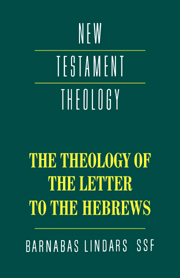1 - The historical setting of Hebrews
Published online by Cambridge University Press: 03 February 2010
Summary
INTRODUCTION
The author of Hebrews ranks with Paul and the Fourth Evangelist as one of the three great theologians of the New Testament. In each case we can see the emergence of a distinctively Christian theology in response to the gospel of Jesus Christ. So in Hebrews we see Christian theology in the making, as the writer (to whom I shall refer to as Hebrews) builds up his argument on the meaning of Christ's death. We share in a creative experience because Hebrews has seized ideas not previously exploited.
Two ideas are unique in the New Testament. The priesthood of Jesus after the order of Melchizedek is entirely new, and adds a fresh dimension to the development of christology. There is no evidence that this had been applied to Jesus previously. We shall see that it was wrung from Hebrews by the special needs of the problem to which the letter is addressed. Similarly his use of the ceremonial of the Day of Atonement to expound the sacrificial death of Jesus goes beyond any previous expositions of the faith that ‘Christ died for our sins' (1 Cor. 15.3). Again it arises directly from the particular character of the pressing problem which confronts Hebrews.
- Type
- Chapter
- Information
- The Theology of the Letter to the Hebrews , pp. 1 - 25Publisher: Cambridge University PressPrint publication year: 1991



